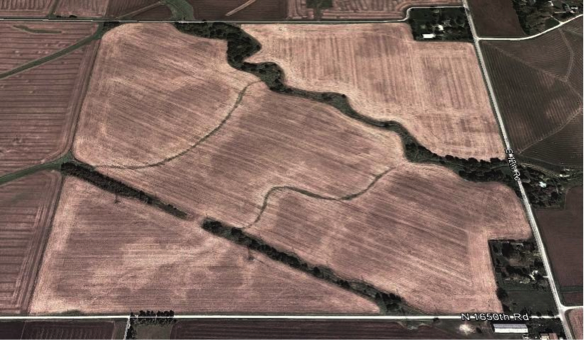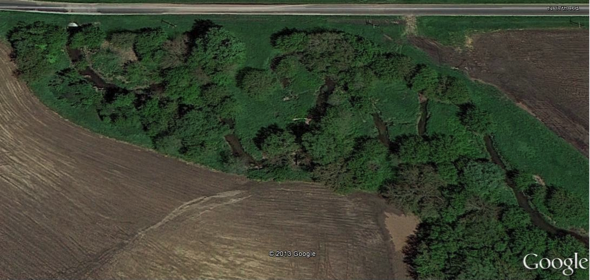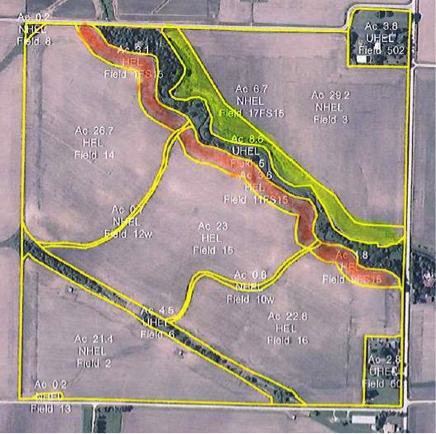My connection to Habitat 2030 began with a simple conversation. On a mildly cold December day at a restoration workday at the Jarvis Bird Sanctuary, I was speaking to a girl working towards the required certifications to steward a site within the jurisdiction of the Chicago Park District. She mentioned the organization and their purpose, empowering young people to become the next generation of restoration leaders. At the time I barely understood what the term restoration meant.
I imagine she attended the Jarvis workday for the same reason I had, to acquire knowledge about restoration for her project. My own restoration project had come to mind less than a month prior. In the past several years my family had begun an annual Thanksgiving tradition, playing paintball along the lightly wooded, zigzagging creek that ran through our 150 acre row crop farm.
In the back of my mind, I’ve known for quite a while that the area could use some work. Where are the tall trees I remember from camping there in my youth? Why does the vegetation seem to consist mostly of poison ivy, thorn bushes, garlic mustard, and poison hemlock? My plant knowledge was fairly non-existent at the time, but I intuitively knew that monocultures of scraggly mulberry trees and agricultural weeds was a far cry from the wilderness playground my nostalgia imagined it to be. I needed the knowledge to make it better!
That led me to the Jarvis Bird Sanctuary, and that conversation led me to Habitat 2030. Within a month or two, I attended a massive winter solstice bonfire, North Branch seed processing, and a few Forest Preserve workdays and nature hikes. It didn’t take long to get hooked. Through the group I discovered that there was an extensive volunteer restoration underground, quietly devoting countless hours of invasive species removal, seed collecting, mixing, and broadcasting, cage-making, herbicide application, and trail construction and maintenance. I learned that the FPCC Volunteer Resource Center provides a multitude of learning opportunities, from monitoring invasives, to managing brush pile burns, to operating chainsaws. This went well beyond the litter cleanup and weed pulling that many people associate with park volunteering. I also discovered the vast network of organizations mired in the realm of ecology. The Chicago Botanic Gardens, Friends of the Forest Preserve, Midewin National Tallgrass Prairie, the North Branch Restoration Project and North Park Village Nature Center are just a few of the names and places that I began to hear on a regular basis.
In addition to all these official resources, there was the casual knowledge and expertise offered by others within the restoration network. For the most part, I’ve found these people to be genuinely interested, even excited, about my project. They have on many occasions provided me with advice that has inspired me to up the ante, to bolster my vision of what is practical and achievable. While my initial plan was to break up some dams, prune existing trees, plant some new trees, remove some invasive species, and plant some shrubs and native plants, it has expanded greatly.
For example, while discussing state supported erosion control, one connection recommended the Conservation Reserve Program, or CRP. Some basic online research connected me to the county representative for CRP, the USDA Farm Service Agency’s program to remove environmentally sensitive land from farm production and replace with helpful plant species in exchange for a modest annual rental payment. For farm land that is exposed to flooding and erosion, the crop yields are already poor, and the rental payments create a win-win-win for individual farmers (positive financial outcomes), sustainable economic development (long-term soil quality), and the environment (water quality, wildlife habitat). A little correspondence between the county representative and my family, and we now have an estimate for a 15 year contract for 15.2 acres on the north and south banks of the creek.
Now, the prospect of tripling the acreage of land buffer between the crops and the creek is on the horizon. Organizing prescribed burns and large group workdays is entirely feasible. Databases of existing and introduced plant species, maps of seed collection and dispersal projects, time lapse photos of habitat changes – really the possibilities are endless. One thing is certain – between workdays for the Forest Preserves and my own side restoration project – I doubt I’ll run out of things to do for a few decades.
Scott Mohan
Latest posts by Scott Mohan (see all)
- Musings on a Farm Restoration: Part 1 - October 2, 2015
- Natural Phenomenon in an Urban Metropolis - July 30, 2015




I think that’s a noble idea. Your heart can really be into this project. I missed your your site is my wife has land in Thawville Il. I thought of returning this patch unharmed back to prairie
Sorry for miss spells thanks to Apple spell correct
You should also take the Chicago Wilderness prescribed burn training and volunteer to help with burning. This is critical for maintaining the native ecosystems in our region.
Scott, this is awesome! Let me know if you need help!